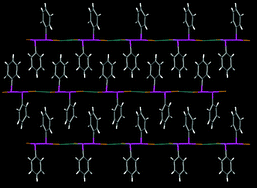A series of di(para-halophenyl)diselenides, (p-XC6H4)2Se2 (X = F, Cl) have been reacted with three equivalents of SO2Cl2 or Br2, leading to the formation of selenium(IV) RSeX3 compounds. The structures of (p-FC6H4)SeX3 (X = Cl, Br) have been determined, and both exhibit a dimeric RSeX2(μ-X)2RSeX2 structure consisting of two “saw-horse” (p-FC6H4)SeX3 units linked by two halide bridges, with an overall square pyramidal geometry at selenium. In both structures all the selenium and halogen atoms are planar, with both aryl rings located on the same side of the Se2X6 plane (cis-isomer). The structure of (p-ClC6H4)SeCl3 also adopts a planar dimeric structure, however both cis- and trans-dimeric molecules are co-crystallised in the unit cell. In contrast, the structure of (p-ClC6H4)SeBr3 adopts a folded cis-dimeric structure due to steric constraints. Secondary Se⋯X interactions to the “vacant” sixth coordination site at selenium are a feature of most of these structures, but are most prominent in the folded structure of (p-ClC6H4)SeBr3. A re-examination of the PhSeBr/PhSeBr3 system resulted in the isolation of crystals of a second structural form of “PhSeBr”. The structure of Ph2Se2Br2 consists of two PhSeBr units linked by an elongated Se–Se bond of 2.832(4) Å, and longer secondary Se⋯Br interactions of 3.333(4) Å to form a chain structure. Further weak Se⋯Br and Br⋯Br interactions are present, which form loosely linked rippled sheets of selenium and bromine atoms, similar to the sheets observed for the tetrameric form, Ph4Se4Br4.

You have access to this article
 Please wait while we load your content...
Something went wrong. Try again?
Please wait while we load your content...
Something went wrong. Try again?


 Please wait while we load your content...
Please wait while we load your content...